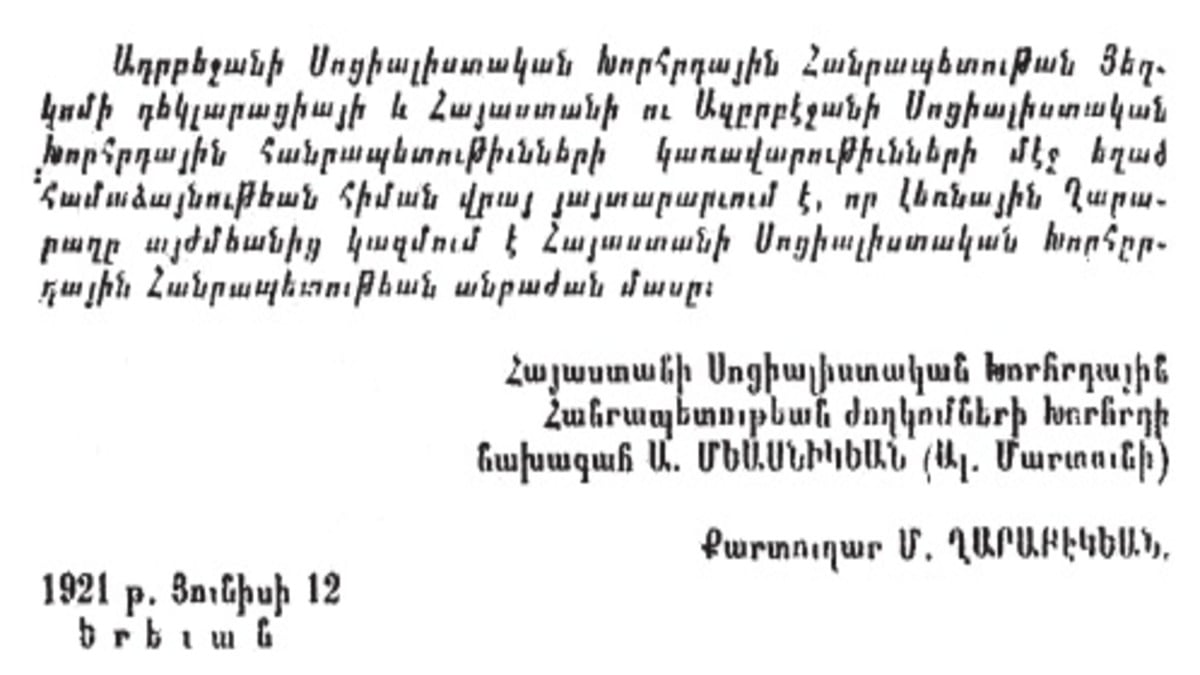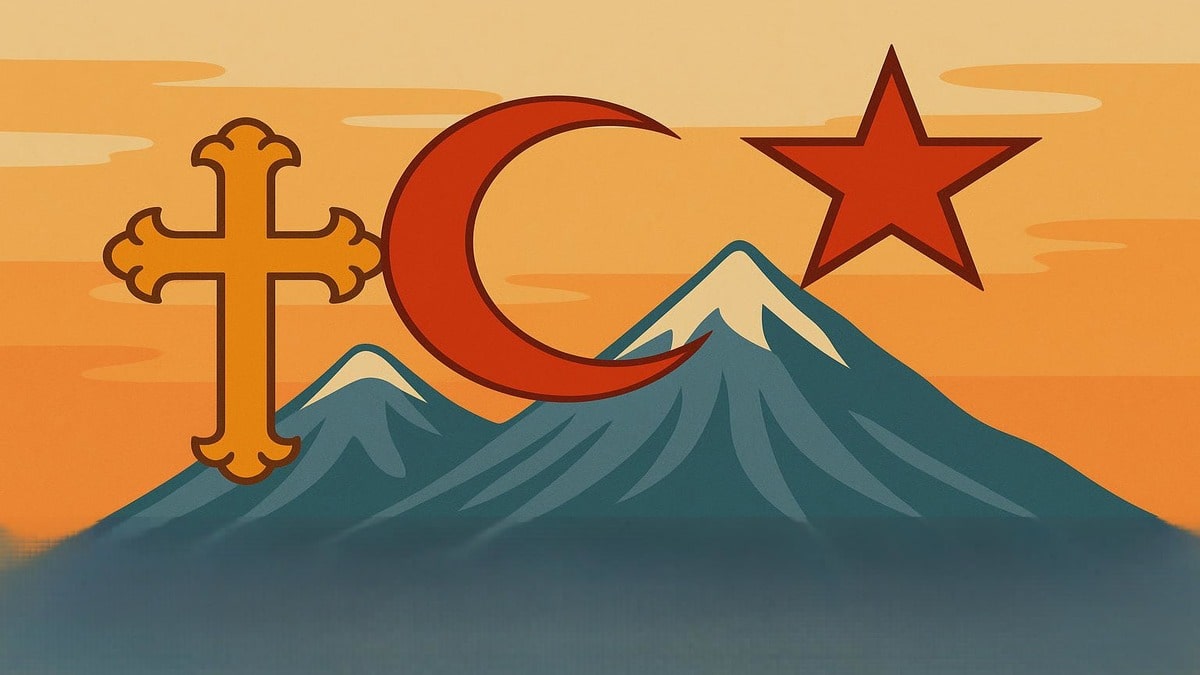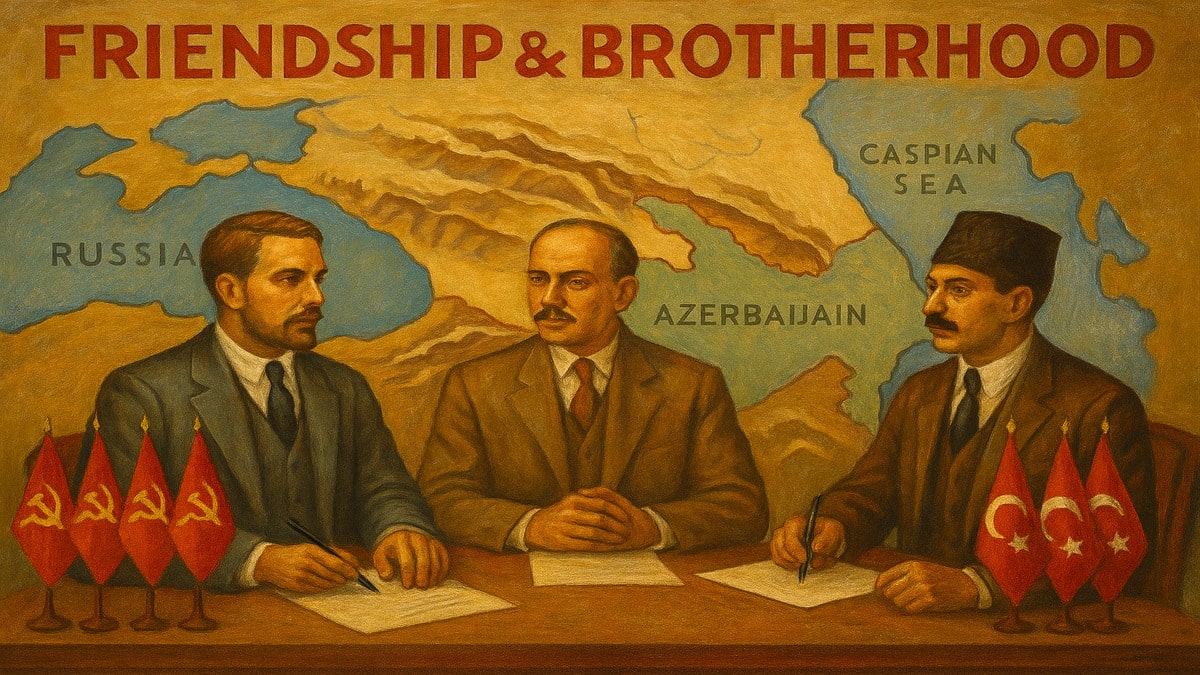
To Deputy Chairman of the Revolutionary Military Council of the Republic E. Sklyansky and Commander-in-Chief of the Republic S. Kamenev On the Offensive Preparations by I. Stalin, S. Kirov, and G. Ordzhonikidze of the 11th Red Army toward Erivan November 10, 1920
At the apparatus: Member of the Revolutionary Military Council of the Front, Comrade Trifonov. Please transmit the following note to Comrades Sklyansky and Kamenev.
To Deputy Chairman of the Revolutionary Military Council of the Republic Sklyansky and Commander-in-Chief Kamenev: Member of the RVS of the 11th Army, Comrade Mikhailov, informed me that Comrades Stalin, Ordzhonikidze, and Kirov are insisting on the immediate issuance of a political directive to the 11th Army to concentrate its forces in the Kazakh region for a possible advance on Erivan. They justify the urgency of this consolidation by the Turkish capture of Alexandropol. The Army’s order for concentration must be issued no later than tomorrow morning, November 11. Awaiting response at the apparatus.
RGVA, f. 6, op. 10, d. 303, l. 282.
📻 Radiogram from G. Chicherin to L. Krasin
On the Critical Situation in Armenia and the RSFSR’s Proposed Mediation Regarding Disputed Territories of Karabakh, Zangezur, and Nakhichevan Moscow–London, November 11, 1920
Soviet Russia has proposed mediation between Turkey and Armenia. Following recent successes by Turkish nationalists, Armenia’s situation is extremely critical, making Russian mediation timely. Soviet Russia has never intended to annex Nakhichevan, Julfa, Zangezur, or Karabakh. The Russian army occupied these disputed territories pending resolution of their status between Armenia and Azerbaijan. Each of these states claims rights to these areas. Nakhichevan is predominantly Muslim, while Zangezur has a mixed population, further complicating the issue.
Chicherin CGIA of Armenia, f. 200, op. 1, d. 597, l. 142. Certified copy. Typescript. Published in: Vestnik Arkhivov Armenii, 1967, No. 3, Doc. No. 41, p. 76; 1989, No. 1, p. 123.
📝 Telegram from I. Stalin to V. Lenin
On the Necessity of Sovietizing Armenia and Creating a Buffer Between Turkey and Azerbaijan Vladikavkaz, November 16, 1920
[Excerpt] Second aspect: the threat from Turkey. If Turkey consolidates its position in Armenia and gains a direct border with Azerbaijan, this poses a serious danger. To prevent this, we must take advantage of the current situation to Sovietize Armenia and insert a Soviet Armenian wedge between Turkey and Azerbaijan.
RGASPI, f. 558, op. 1, d. 1999, l. 3. Telegraph form. Original.
📡 Radiogram from I. Stalin via Direct Line to V. Lenin
On Expansionist Intentions of the Kemalists, Azerbaijan, and Georgia Toward Armenia, Their Potential Alliance with the Entente, and the Need to Block Turkish Access to Azerbaijan November 23, 1920
[Excerpt] First. Information from Mdivani in Erivan, still partially deciphered, indicates the following: Armenia’s military forces have collapsed; the Turks could occupy all of Armenia with ease. Kemal’s representative in Tiflis, Kazimbey, is behaving suspiciously. Mdivani believes the occupation of Armenia may be occurring with some degree of agreement between the Kemalists and Georgia, possibly with the knowledge or consent of the Entente.
Second. According to Ordzhonikidze, the Turks are already attempting to establish contact with discontented Azerbaijani elements, accepting petitions from them and seeking a shared border with Azerbaijan—especially dangerous at this moment.
RGASPI, f. 2, op. 1, d. 16244, l. 1–3 verso. Original. Autograph.
📻 Radiogram from RSFSR Plenipotentiary in Armenia B. Legran
To People’s Commissar for Foreign Affairs G. Chicherin and Member of the Caucasian Bureau of the RCP(b) Central Committee and RVS of the Caucasian Front G. Ordzhonikidze On the Need to Suspend the Entry of the Red Army and Revolutionary Committee into Armenia Erivan, November 30, 1920
The advance of our troops and the Revolutionary Committee must be immediately suspended and postponed until December 3. Dro has undertaken obligations to ensure that by that time all necessary measures will be taken to allow our forces to enter Armenia without resistance from the government or army units. We must comply with this necessity and avoid precipitating events unnecessarily. Otherwise, our entry will appear as hostile action against Armenia in conjunction with the Turks, in which case I categorically renounce all responsibility for the course of events. Please issue immediate instructions to the Revolutionary Committee and local command to prevent any unauthorized actions. Notify me immediately upon receipt of this radiogram and the measures taken.
Legran RGASPI, f. 64, op. 1, d. 21, l. 264. Copy.
📝 Telegram from I. Stalin to RSFSR Plenipotentiary in Angora P. Mdivani
On Using the Territorial Dispute with Soviet Azerbaijan to Justify RSFSR Mediation Between Turkey and Armenia Transmitted via G. Ordzhonikidze, November 30, 1920
If rejection of mediation excludes our participation in peace negotiations between Armenia and Turkey, then both Turks and Armenians must be reminded that in such a case, the issue of Zangezur and the Nakhichevan district cannot be discussed at the Armenian-Turkish conference, as both territories are disputed between Armenia and Azerbaijan, with which Russia is allied.
RGASPI, f. 558, op. 2, d. 82, l. 1. Original. Autograph.
📘 Annual Report of the RSFSR People’s Commissariat for Foreign Affairs to the Eighth Congress of Soviets
On the Causes of the War Between Bolshevik Russia and Soviet Azerbaijan Against Armenia and the Unratified Peace Agreements December 22–29, 1920
[Excerpt] One of the most contentious issues in the Caucasus is the delineation of borders between the national republics. Since Azerbaijan became a Soviet Republic and a vanguard of the workers’ and peasants’ regime in the East, its previous border disputes with neighboring republics have been further complicated by ideological differences. Relations between Azerbaijan and Dashnak Armenia became even more strained. In Zangezur, Karabakh, the Nakhichevan district, and the Sharur-Daralagiaz region, the national struggle between Armenians and Muslims was exacerbated by the global conflict between Entente imperialism—represented by the Dashnaks—and the Soviet world, whose vanguard was Azerbaijan. In the interest of peace, the Soviet government decided to occupy the disputed zone between Armenia and Azerbaijan with its own forces. This led to clashes between Red Army units and Dashnak detachments, as well as attempts by the Dashnaks to organize uprisings in Armenian-populated areas behind Red Army lines. This armed conflict ended with a preliminary peace agreement signed on August 10 by our plenipotentiary Legran in Erivan. According to the October 28 treaty, Armenia renounced its claims to Karabakh but received Zangezur and Nakhichevan.
Annual Report of the NKID to the VIII Congress of Soviets (1919–1920). Moscow, 1921. Manuscript; USSR Ministry of Foreign Affairs. Documents of Soviet Foreign Policy, Vol. II, Moscow: Gospolitizdat, 1958. 577
Yuri Barsegov “Nagorno-Karabakh in International Law and Global Politics”
Artatsolum
Read Also:
- Ancient and Medieval Sources on Artsakh (Karabakh) as Part of Armenia’s State Territory
- Message from Gandzasar Catholicos Esayi to Peter I August 10, 1716
- Memorandum Issued to Ivan Karapet Along with the Imperial Letter to the Armenian People Regarding Russia’s Readiness to Take the Armenians of Karabakh Under Its Protection June 3, 1723
- Decree of Peter I to the Armenian People Regarding Russia’s Willingness to Offer Protection to the Armenians of Karabakh
- On Armenian Hopes for Russian Assistance
- Report of Minas Vardapet to Peter I
- Contents of the Secret Letters from the Armenian Assembly and the Armenian Army of Karabakh to the Russian Emperor and Chancellor August 1724
- Contents of the Secret Letters from the Armenian Assembly and the Armenian Army of Karabakh to the Russian Emperor and Chancellor August 1724
- State Charter of Peter I On the Acceptance of the Armenian People Under the Protection of the Russian State and Their Resettlement from Karabakh to Newly Acquired Persian Provinces November 10, 1724
- Letters from the Catholicos and the Meliks of Karabakh
- Charter of Catherine I Addressed to the Armenian Assembly
- Message General Mkhitar—to the Russian Government
- The Armenian Assembly’s Request for Military Assistance June 19, 1727
- Result from Russia’s failure to fulfill its promises of assistance to the Armenians March 1736
- On the Issuance of the Decree Appointing Panah Khan
- Letter from General Potemkin to Prince Argutinsky with questions about the liberation of Armenia
- Appeal of Gandzasar Catholicos Hovhannes to Catherine II
- Letter from Melik Apov Iosifov to Provide Assistance to Russian Military Forces for the Liberation of Enslaved Karabakh
- Report of Prince G. Potemkin to Catherine II
- Request of General P. Potemkin to Prince G. Potemkin
- Letter from Archbishop Joseph Argutinsky to General P. Potemkin
- Memorandum to Catherine II on the Project for the Restoration of the Armenian Kingdom
- Decree of Paul I to General Count I. Gudovich
- Letter from Archbishop Joseph Argutinsky
- Report by State Councillor P. Kovalesky
- The Khan’s Vizier, Mirza Jamal Javanshir Karabakhsky
- From the Report of General Marquis Palluci to Alexander I
- The Gulistan Treaty – An Interstate Act of Iran’s Cession of the Karabakh Territory to Russia
- Report of General A. Yermolov to Alexander I Requesting the Waiver of Tax Arrears for the Karabakh Khanate
- LETTER FROM GENERAL A. YERMOLOV TO MEHTI-KULI KHAN
- Directive from General A. Yermolov to General I. Velyaminov
- Letter of Metropolitan Sarkis Hasan-Jalalyan To General A. Yermolov
- Letter from General I. Paskevich
- TREATY CONCLUDED BETWEEN RUSSIA AND PERSIA AT TURKMENCHAY
- Russian Military Historian V. Potto on the Essence of the Treaty of Turkmenchay
- Order of General I. Paskevich to Colonel L. Lazarev
- STATEMENT ON THE DIFFERING ATTITUDES OF ARMENIANS AND TATARS TOWARD THE ANNEXATION OF KARABAKH TO RUSSIA
- REPORT By the Acting Uezd Chief of the Dzhevanshir Uezd, D. Baranovsky
- From the Memoirs of a Member of the Russian National Council in Baku (1918–1919)
- “TREATY OF PEACE AND FRIENDSHIP” Between the Ottoman Empire and the Republic of Armenia
- Letter from A. Mikaelyan, Representative of the Karabakh and Zangezur Fellowship
- Note of Protest from the Ministry of Foreign Affairs of the Republic of Armenia
- Appeal of the Karabakh Armenian National Council To the Commander of Allied Forces in Baku
- LETTER FROM THE CHAIRMAN OF THE KARABAKH ARMENIAN NATIONAL COUNCIL
- Turks in Shushi
- Letter of Welcome from the Karabakh Armenian
- LETTER FROM GENERAL BAGRATUNI
- FROM THE MESSAGE OF THE ARMENIAN TELEGRAPH AGENCY
- REPORT FROM THE DIPLOMATIC REPRESENTATIVE OF ARMENIA IN GEORGIA
- Resolution of the Fifth Congress of Armenians of Karabakh
- Report by Prime Minister Hatisov to the Council of Ministers of Armenia
- FROM THE MEMORANDUM OF THE KARABAKH ARMENIAN NATIONAL COUNCIL
- 🇬🇧 ANNOUNCEMENT OF THE BRITISH MILITARY MISSION IN SHUSHA
- From the Memorandum of the Armenian Representative to the British Military Mission in Shusha
- Report from the Office of the Governor-General of Karabakh
- NOTICE FROM THE REPRESENTATIVE OF THE BRITISH MILITARY MISSION IN SHUSHI
- 🇬🇧 Doubts Expressed by British Delegate Eric Forbes Adam
- LETTER FROM THE ARMENIAN DIPLOMATIC REPRESENTATIVE
- Assessment by the Karabakh Armenian National Council
- “The Caucasian Word” on the Confirmation by a British Command Representative
- Letter from the Acting Governor-General of Karabakh
- OVERVIEW OF THE SITUATION IN THE CAUCASUS
- Proclamation of the Zangezur Armenian National Council
- Telegram from the Prime Minister of Armenia to the British High Commissioner
- MESSAGE TO THE DIPLOMATIC REPRESENTATIVE
- Photographic Evidence of the Annihilation of Shushi’s Thirty-Thousand Strong Armenian Population
- Appeal of the Karabakh Soldiers and Officers of the Armenian Army
- Territorial Dispute Between the Azerbaijan SSR (as part of the RSFSR) and the Republic of Armenia
- Telegram from the Minister of Foreign Affairs of Armenia
- Telegram from G. Ordzhonikidze to V. Lenin, I. Stalin, and G. Chicherin
- LETTER FROM MEMBERS OF THE CAUCASIAN BUREAU OF THE CENTRAL COMMITTEE OF THE RCP(B): A. AVANESOV, R. KATANYAN, AND AYKUNI
- Report of the Karabakh Community Delegation of Tiflis
- From the Report of People’s Commissar for Foreign Affairs of the RSFSR
- Letter from the People’s Commissar for Foreign Affairs of the RSFSR, G. Chicherin, to V. Lenin
- EXCERPT FROM THE MINUTES OF THE MEETING OF THE POLITBURO
- LETTER FROM MEMBERS OF THE CAUCASUS BUREAU OF THE CENTRAL COMMITTEE OF THE RCP(B)
- LETTER FROM MEMBERS OF THE CAUCASUS BUREAU OF THE CENTRAL COMMITTEE OF THE RCP(B) 11TH RED ARMY
- Telegram from the People’s Commissar for Foreign Affairs of the RSFSR, G. Chicherin
- Appeal from the Commander of the Armenian Expeditionary Detachment
- TELEGRAM OF THE PLENIPOTENTIARY REPRESENTATIVE OF THE RSFSRIN ARMENIA B. LEGRAND
- Letter from Armenian Foreign Minister A. Ohandjanian to the Head of the French Military Mission
- Telegram from Member of the Caucasian Bureau of the Central Committee
- Telegram from Member of the Caucasian Bureau of the Central Committee of the RCP(b)
- First Addendum to the Draft Peace Treaty between the RSFSR and the Republic of Armenia


